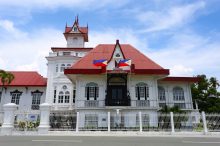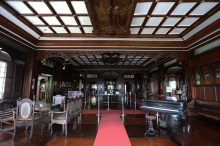Museo ni Emilio Aguinaldo, the Philippines

 Emilio Aguinaldo was a Filipino revolutionary, politician and a military leader who is officially recognised as the first President of the Philippines (1899-1901).
Dubbed as "the House of History", the Aguinaldo Mansion that currently hosts the Museo ni Emilio Aguinaldo is the locus of a focal point in the unfolding of Philippine history. Constructed in 1845, the original structure of the house was of nipa-and-thatch material. It was reconstructed four years later using a variety of Philippine hardwood. By the 1920s, major renovation saw the construction of the tower and the symbolic balcony of the house. It was also during this period that the house was refurbished with architectural details of nationalistic themes, masonic symbols, and art nouveau and art deco’s artistic style prevalent during the early 20th century.
The house where the president lived was donated to the Filipino people in 1963, a year before he passed away. In 1964, the house was placed under the care of the National Museum of the Philippines and was declared a national shrine through Republic Act No 4039. By 1972, Executive Order No 370 transferred the shrine under the care and maintenance of the National Historical Commission of the Philippines.
Today, Museo ni Emilio Aguinaldo continues to emanate the vision of a free and proud nation as it perpetuates the ideals of the 1896 Revolution and the 1898 Proclamation of Philippine Independence.
Permanent collections: The Museo ni Emilio Aguinaldo’s collection covers a variety of museum objects. The ground level of the house is a permanent exhibit on the role of the area of Cavite during the revolution. It presents the life of General Aguinaldo, Cavite during the Spanish colonial period, and the revolution against Spain until the proclamation of independence on June 12, 1898. It also covers the aftermath of the revolution until the Philippines’ war against the United States.
The second level is the living space of the house. Similar to the traditional "bahay na bato" structure of the 19th century; the living room, the bedrooms, dining area and kitchen can all be found in this level. These rooms house 19th-century and early 20th-century furniture and details of the art nouveau and art deco period of the past. Notable are the mesa altar, large dining table, Ah Tay bed and secret compartments oblivious to regular guests.
Emilio Aguinaldo was a Filipino revolutionary, politician and a military leader who is officially recognised as the first President of the Philippines (1899-1901).
Dubbed as "the House of History", the Aguinaldo Mansion that currently hosts the Museo ni Emilio Aguinaldo is the locus of a focal point in the unfolding of Philippine history. Constructed in 1845, the original structure of the house was of nipa-and-thatch material. It was reconstructed four years later using a variety of Philippine hardwood. By the 1920s, major renovation saw the construction of the tower and the symbolic balcony of the house. It was also during this period that the house was refurbished with architectural details of nationalistic themes, masonic symbols, and art nouveau and art deco’s artistic style prevalent during the early 20th century.
The house where the president lived was donated to the Filipino people in 1963, a year before he passed away. In 1964, the house was placed under the care of the National Museum of the Philippines and was declared a national shrine through Republic Act No 4039. By 1972, Executive Order No 370 transferred the shrine under the care and maintenance of the National Historical Commission of the Philippines.
Today, Museo ni Emilio Aguinaldo continues to emanate the vision of a free and proud nation as it perpetuates the ideals of the 1896 Revolution and the 1898 Proclamation of Philippine Independence.
Permanent collections: The Museo ni Emilio Aguinaldo’s collection covers a variety of museum objects. The ground level of the house is a permanent exhibit on the role of the area of Cavite during the revolution. It presents the life of General Aguinaldo, Cavite during the Spanish colonial period, and the revolution against Spain until the proclamation of independence on June 12, 1898. It also covers the aftermath of the revolution until the Philippines’ war against the United States.
The second level is the living space of the house. Similar to the traditional "bahay na bato" structure of the 19th century; the living room, the bedrooms, dining area and kitchen can all be found in this level. These rooms house 19th-century and early 20th-century furniture and details of the art nouveau and art deco period of the past. Notable are the mesa altar, large dining table, Ah Tay bed and secret compartments oblivious to regular guests.Similar content
05 Nov 2016
